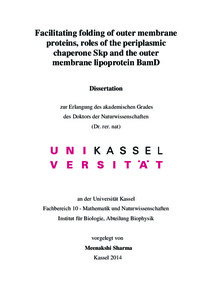Dissertation

Facilitating folding of outer membrane proteins, roles of the periplasmic chaperone Skp and the outer membrane lipoprotein BamD
Zusammenfassung
This thesis describes several important advancements in the understanding of the assembly of outer membrane proteins of Gram-negative bacteria like Escherichia coli. A first study was performed to identify binding regions in the trimeric chaperone Skp for outer membrane proteins. Skp is known to facilitate the passage of unfolded outer membrane proteins (OMPs) through the periplasm to the outer membrane (OM). A gene construct named “synthetic chaperone protein (scp)” gene was used to express a fusion protein (Scp) into the cytoplasm of E. coli. The scp gene was used as a template to design mutants of Scp suitable for structural and functional studies using site-directed spectroscopy. Fluorescence resonance energy transfer (FRET) was used to identify distances in Skp-OmpA complexes that separate regions in Scp and in outer membrane protein A (OmpA) from E. coli. For this study, single cysteine (Cys) mutants and single Cys - single tryptophan (Trp) double mutants of Scp were prepared. For FRET experiments, the cysteines were labeled with the tryptophan fluorescence energy acceptor IAEDANS. Single Trp mutants of OmpA were used as fluorescence energy donors.
In the second part of this thesis, the function of BamD and the structure of BamD-Scp complexes were examined. BamD is an essential component of the β-barrel assembly machinery (BAM) complex of the OM of Gram-negative bacteria. Fluorescence spectroscopy was used to probe the interactions of BamD with lipid membranes and to investigate the interactions of BamD with possible partner proteins from the periplasm and from the OM. A range of single cysteine (Cys) and single tryptophan (Trp) mutants of BamD were prepared. A very important conclusion from the extensive FRET study is that the essential lipoprotein BamD interacts and binds to the periplasmic chaperone Skp. BamD contains tetratrico peptide repeat (TPR) motifs that are suggested to serve as docking sites for periplasmic chaperones such as Skp.
In the second part of this thesis, the function of BamD and the structure of BamD-Scp complexes were examined. BamD is an essential component of the β-barrel assembly machinery (BAM) complex of the OM of Gram-negative bacteria. Fluorescence spectroscopy was used to probe the interactions of BamD with lipid membranes and to investigate the interactions of BamD with possible partner proteins from the periplasm and from the OM. A range of single cysteine (Cys) and single tryptophan (Trp) mutants of BamD were prepared. A very important conclusion from the extensive FRET study is that the essential lipoprotein BamD interacts and binds to the periplasmic chaperone Skp. BamD contains tetratrico peptide repeat (TPR) motifs that are suggested to serve as docking sites for periplasmic chaperones such as Skp.
Förderhinweis
Prof. Dr. Jörg H. KleinschmidtZitieren
@phdthesis{urn:nbn:de:hebis:34-2014092546079,
author={Sharma, Meenakshi},
title={Facilitating folding of outer membrane proteins, roles of the periplasmic chaperone Skp and the outer membrane lipoprotein BamD},
school={Kassel, Universität, FB 10, Mathematik und Naturwissenschaften, Institut für Biologie},
month={09},
year={2014}
}
0500 Oax
0501 Text $btxt$2rdacontent
0502 Computermedien $bc$2rdacarrier
1100 2014$n2014
1500 1/eng
2050 ##0##urn:nbn:de:hebis:34-2014092546079
3000 Sharma, Meenakshi
4000 Facilitating folding of outer membrane proteins, roles of the periplasmic chaperone Skp and the outer membrane lipoprotein BamD / Sharma, Meenakshi
4030
4060 Online-Ressource
4085 ##0##=u http://nbn-resolving.de/urn:nbn:de:hebis:34-2014092546079=x R
4204 \$dDissertation
4170
5550 {{Escherichia coli}}
5550 {{Membranproteine}}
7136 ##0##urn:nbn:de:hebis:34-2014092546079
<resource xsi:schemaLocation="http://datacite.org/schema/kernel-2.2 http://schema.datacite.org/meta/kernel-2.2/metadata.xsd"> 2014-09-25T11:44:53Z 2014-09-25T11:44:53Z 2014-09-25 urn:nbn:de:hebis:34-2014092546079 http://hdl.handle.net/123456789/2014092546079 Prof. Dr. Jörg H. Kleinschmidt eng Urheberrechtlich geschützt https://rightsstatements.org/page/InC/1.0/ 570 Facilitating folding of outer membrane proteins, roles of the periplasmic chaperone Skp and the outer membrane lipoprotein BamD Dissertation This thesis describes several important advancements in the understanding of the assembly of outer membrane proteins of Gram-negative bacteria like Escherichia coli. A first study was performed to identify binding regions in the trimeric chaperone Skp for outer membrane proteins. Skp is known to facilitate the passage of unfolded outer membrane proteins (OMPs) through the periplasm to the outer membrane (OM). A gene construct named “synthetic chaperone protein (scp)” gene was used to express a fusion protein (Scp) into the cytoplasm of E. coli. The scp gene was used as a template to design mutants of Scp suitable for structural and functional studies using site-directed spectroscopy. Fluorescence resonance energy transfer (FRET) was used to identify distances in Skp-OmpA complexes that separate regions in Scp and in outer membrane protein A (OmpA) from E. coli. For this study, single cysteine (Cys) mutants and single Cys - single tryptophan (Trp) double mutants of Scp were prepared. For FRET experiments, the cysteines were labeled with the tryptophan fluorescence energy acceptor IAEDANS. Single Trp mutants of OmpA were used as fluorescence energy donors. In the second part of this thesis, the function of BamD and the structure of BamD-Scp complexes were examined. BamD is an essential component of the β-barrel assembly machinery (BAM) complex of the OM of Gram-negative bacteria. Fluorescence spectroscopy was used to probe the interactions of BamD with lipid membranes and to investigate the interactions of BamD with possible partner proteins from the periplasm and from the OM. A range of single cysteine (Cys) and single tryptophan (Trp) mutants of BamD were prepared. A very important conclusion from the extensive FRET study is that the essential lipoprotein BamD interacts and binds to the periplasmic chaperone Skp. BamD contains tetratrico peptide repeat (TPR) motifs that are suggested to serve as docking sites for periplasmic chaperones such as Skp. open access Sharma, Meenakshi Kassel, Universität, FB 10, Mathematik und Naturwissenschaften, Institut für Biologie Kleinschmidt, Jörg H. (Prof. Dr.) Herberg, Friedrich W. (Prof. Dr.) Escherichia coli Membranproteine 2014-09-08 </resource>
Die folgenden Lizenzbestimmungen sind mit dieser Ressource verbunden:
Urheberrechtlich geschützt

